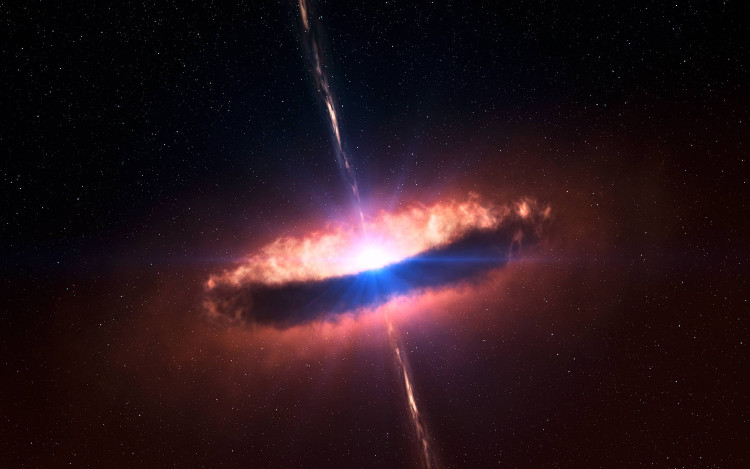What is Hypernova?
The following article will give you the most basic concept about Hypernova (or superstellar explosion), please consult.
What is Hypernova?
Hypernova is a particularly large star that collapses at the end of its life. Until the 1990s, it refers to an energy explosion with energy of more than 100 supernovae (over 1048 J). Such an explosion is thought to be the source of long-time gamma flashes.
After the 1990s, the term was used to describe supernovae of the largest stars, ultra-massive stars, weighing 100 to 300 times more than the Sun. Decay 56Ni, a short-lived isotope of nickel, is believed to have provided most of the light of hypernova.

Hypernova is a particularly large star that collapses at the end of its life.
The radiation produced by a hypernova at close range can cause serious damage to the Earth, however no super-giant star is known to be close enough to the Earth to pose a threat. The group led by Brian Thomas, an astrophysicist at Washburn University in Kansas, has speculated that a hypernova could have caused the Ordovician-Silur mass extinction on Earth 440 million years ago, But there is no clear evidence to prove.
The word collapsar , short for collapsed star , was previously used to indicate the final result of star gravity collapse, a stellar black hole. Now this word is sometimes used to refer to a specific model for the collapse of a spinning star so fast.
The collapse of stars
The core of hypernova collapses directly into a black hole , and two powerful plasma currents are ejected at a rate close to the speed of light from its rotating poles. These plasma currents emit intense gamma rays and are a possible explanation for long-gamma flashes. However, hypernovas cannot be used to explain short-time gamma flashes, which do not seem to have anything to do with big stars, because some short bursts occur in areas without star formation. new - a necessity because giant stars have short lifetimes and therefore must be born.
The energy produced by the hypernova of a large star, along with the luminous effect, is necessary to explain the extremely large brightness and distance (over 10 light years, as measured by the red shift of afterglow ionization. ) of long-duration gamma flashes (> 2 seconds), where gamma emission on 1044 J is needed. The main mechanism is that when strong energy flows are formed at the rotating axis of the black hole, high-energy radiation bursts will appear to the observer on the path of the plasma flow, even at a distance. far to the edge of the universe can be observed. So far, hypernova and long gamma flashes have been seen in other galaxies, but have not been observed in our galaxy.
Because stars are big enough to collapse directly into a black hole is quite rare, so hypernova will be very rare , if they actually happen. It is estimated that every 200 million years hypernova will occur in our galaxy.
In recent years, a large amount of observational data on long-time gamma flashes has significantly increased our understanding of these events and made it clear that collapse models create explosions. only more or less specific differences between conventional supernovae. However, sometimes they mention in the document is hypernovae. The word hypernova was coined by SE Woosley.

Supernova unstable 2006gy.
Collapsar is currently being used as the name of a model that assumes where a fast-rotating Wolf-Rayet star with a large core (greater than 30 solar masses) collapses to form a spinning black hole. large, sucking all the surrounding material at a relative speed with the Lorentz coefficient at about 150. The speed makes collapsar become the fastest known object. They can be considered supernovae type Ib and Ic "failed".
A possible example of collapsar is the unusual Sn1998bw supernova , along with the GRB 980425 gamma flash . This supernova has been classified as a supernova type Ic due to its characteristic spectral properties in the radio spectrum, showing the presence of relative matter.
Another type of hypernova, a double supernova , including the 2006gy supernova may have been the first example to be observed. Supernovae are observed in a galaxy about 240 million light-years from Earth (72,000,000 parsec). In a unstable double supernova, pair production causes a sudden drop in pressure in the star's core, leading to a rapid local collapse, causing a sharp increase in temperature and pressure leading to a complete burning fusion and explosion of stars.
- Learn about supernovae and supernovae
- The hypothetical alien was sucked into the black hole
- Stamping automobile shell with virtual technology mold
- The external robot arm costs only 65 USD
- Chen wished to register domain name level 2.vn
- Use Windows Vista with Mark Russinovich
- Treat parasitic diseases to help patients fight HIV
- Blindness with human embryonic stem cells
- Will in-vitro fertilization be at risk of premature death?
- Nobel history and things to know
- Video: How is beer made?
- Artificial rain
- Super Typhoon Melor landed in the Philippines, 3 people died
 Van Allen's belt and evidence that the Apollo 11 mission to the Moon was myth
Van Allen's belt and evidence that the Apollo 11 mission to the Moon was myth The levels of civilization in the universe (Kardashev scale)
The levels of civilization in the universe (Kardashev scale) Today Mars, the sun and the Earth are aligned
Today Mars, the sun and the Earth are aligned The Amazon owner announced a secret plan to build a space base for thousands of people
The Amazon owner announced a secret plan to build a space base for thousands of people